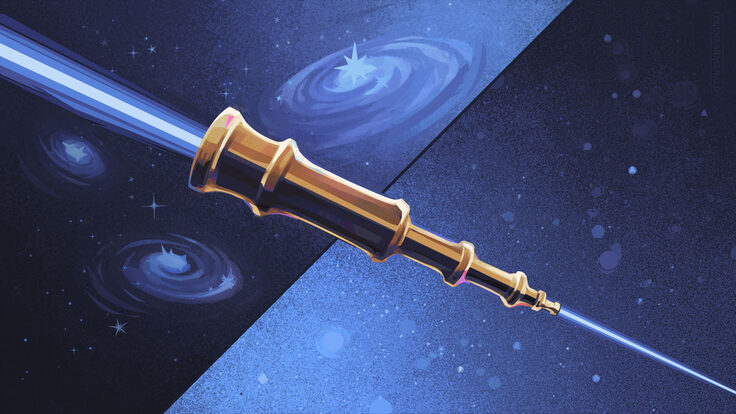The origin of ultra-high-energy cosmic rays is a question that makes it onto many top-unsolved-problems-in-physics lists.

The TAUWER experiment looks at particle showers that originate from tau neutrinos that take short paths through the earth (inset). An ideal site to observe these events is a mountain bowl. Image courtesy of Maurizio Iori.
The math says that these particles, which carry in excess of 1019 electron volts, or eV, from somewhere in outer space, are far too energetic not to have interacted themselves out of existence before reaching the earth. And yet every year scientists see evidence in the earth’s atmosphere of a handful of these particles, which have several million times the energy of the protons being collided at the Large Hadron Collider.
Scientists are proposing a new experiment, called TAUWER, that would look to tau neutrinos to remove some of the mystery from these strange, over-stimulated cosmic rays.
“The question is, how do they get this energy?” says James Russ, TAUWER collaborator and professor of physics at Carnegie Mellon University. “We don’t know what the mechanism is.”
One idea for the mechanism is a rapid rebounding between plasma shock waves. In places such as those near black holes, where charged matter builds to extreme densities, protons may be ricocheting back and forth between shock wave fronts, accelerating and gathering energy over billions of years. Then one day the proton may escape and come to earth in the form of an ultra-high-energy cosmic ray or UHECR.
If these UHECRs are indeed protons escaped from star systems, they’ll reveal their existence, through a series of interactions, by producing ultra-high-energy neutrinos, neutrinos with energies greater than 1016 eV—over a billion times more energetic than those produced by supernovas.
TAUWER detectors would examine the particle showers brought on by these neutrinos’ interaction with the earth. The resulting energy measurements of the tau neutrinos could give scientists information about their conjectured parents, the UHECR protons.
“The neutrinos’ energy spectrum tells you about the nature of the protons’ acceleration,” Russ said. “That’s why it’s an interesting measurement to make.”
Collaborators are interested in particular in tau neutrinos – one of three known types – because of the high chance they’ll end up propagating particle showers that their detectors can see.

Rough layout scheme of TAUWER detectors on a mountainside. The straight blue line represents a tau lepton emerging from the earth. The white lines represent shower tracks from the tau lepton decay. Image courtesy of Maurizio Iori.
TAUWER isn’t the only program that’s using neutrinos to get to cosmic rays. The IceCube experiment at the South Pole looks for lower-energy neutrinos as they barrel through the length of the earth’s diameter with energies of up to 1016 eV. IceCube experimenters are currently busy with creative new schemes to extend their energy reach.
TAUWER picks up where the present IceCube design leaves off. Neutrinos with higher energies may not be able to make it from one end of the planet to the other since they’ll very likely be derailed by the rock in the earth. But if the trip through the earth is short enough, they can still make their way out.
TAUWER detectors would turn their attention particles that fly through short slices of the planet, about 1/13 the diameter of the earth. The neutrinos could, for example, enter San Francisco Bay and, a thousand kilometers later, exit Salt Lake. During these split-second trips through the earth, the ultra-high-energy neutrinos’ interaction with the rock would be close enough to the earth’s surface that its offspring, a tau lepton (a heavy cousin of the electron) could still push its way from beneath the ground into the air. TAUWER detectors, pointed at some angle toward the earth, will see the 1-kilometer-radius particle shower that springs from the tau lepton’s connection with the atmosphere.
The detectors, which have a very high pointing accuracy, can then pick out the direction of the UHECR that started it all. And with enough tau neutrino data, the UHECR phenomenon could very well lose its place on the top-unsolved-problems list – a good thing.
The Pierre Auger experiment in Argentina has also been on a quest to catch glimpses of UHECRs by way of tau neutrinos, but using very different methods. Auger detectors look for UHECRs that come uninterrupted from the sky. TAUWER detectors, on the other hand, would watch the ground to find tau neutrinos that come from below. Russ imagines TAUWER detectors searching for neutrino events from the height of a mountainside. The collaboration is scouting mountain bowls, sites where mountain ridges surround level stretches of land, in Europe, Mexico, and the US.
“A mountain bowl has the lovely feature that it screens horizontal cosmic rays, which are one background source,” Russ said. “You’re sitting on a mountain range that’s looking down on a nice flat space for neutrinos to come up through.”
The collaboration is currently testing a handful of detectors. Once the experiment is running full speed ahead, they’ll run 2,500 small detectors, each about as tall and wide as a CD case. Grouped in fours and spaced about 70 meters apart, the detectors will help map the energy spectrum of tau neutrinos that plow through the earth.
TAUWER collaborators are currently based at Carnegie Mellon University, Sapienza University of Rome and two Turkish institutions in the Bolu and Kars provinces. The TAUWER name is a nod both to the tau neutrino and to the aluminum frames – towers – that support the experiment’s instruments.
“By next summer, we should be ready to find more interested people who want to take on the ice and snow of a mountain environment to help make things work,” Russ said.






